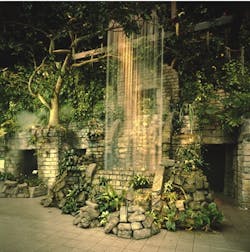Creating the Ultimate Greenwall
Greenwalls aren't exactly new, but their time has certainly come—and you know that's true when you see them appearing in advertisements for one of the biggest fast-food chains in America.
Greenwalls—also known as vertical planting systems, vertical gardens, plant walls, and/or vegetated walls—have been successfully implemented in several projects around the world over the past 15 years. European and Canadian projects have taken the lead in implementing these planting systems.
Most greenwalls are simply vertical planting systems for the interior and exterior of a building. The basic greenwall system is created by providing a planting substrate into a modular wall system. The components of a typical vertical planting system include:
- Plants that have been selected to meet the particular design intent. Interior greenwalls use tropical plants—mostly vining, climbing, and fern varieties. Exterior greenwalls use sedums and other hardy vines and climbers.
- A modular panel system to contain the roots and the growing medium.
- An integrated drip irrigation system and controls.
- A catch basin to control water runoff.
- A structural support system.
Plants stay in place because they're rooted into the growing media, which is held in place by the modular wall system and attached to the wall using a structural support system.
When air is circulated through a greenwall, it becomes an active bio-wall air-filtration system. Basically, greenwalls act as bio-filters, improving air quality by breaking down harmful VOCs and creating clean oxygen. Greenwalls absorb carbon dioxide, release oxygen, and reduce greenhouse gases in the atmosphere. Exterior greenwalls reduce energy consumption by keeping the building cooler in the summer via the plant's transpiration process, which reduces the need for air-conditioning. Both interior and exterior greenwalls create a sound barrier, which reduces noise inside the building. (For more information about the general benefits of incorporating plants into your buildings, visit Loveland, OH-based Green Plants for Green Buildings' website.)
Where Greenwalls Work
Greenwalls first made their appearance in zoological exhibits, but they're adaptable to almost any vertical surface. Whether a greenwall is inside or outside, it adds remarkable visual value to the area, making any visitor take note. They're dramatic, attractive, and distinctive visual statements that send a message saying you care about the environment both inside and outside of your building.
The single biggest factor when it comes to the success of a greenwall is having properly designed systems to maintain it. When designing a greenwall, we look to successful commercial applications and to nature for the basic design of vertical planting systems. (Nature has been producing spectacular vertical landscapes for thousands of years.)
Design Considerations
There are several important design and structural differences between ground-level garden design and vertical garden design. Here are a few special construction requirements and considerations when developing the vertical garden/greenwall:
- Protection of the structural support system's integrity, and waterproofing protection of that system.
- Positive drainage throughout the system so that plantings at the bottom will have optimal growing conditions without becoming oversaturated.
- A long-term, lightweight planting medium that isn't subject to deterioration through decomposition (normally, this is a synthetic product).
- Irrigation and fertilization for optimum plant growth and sustainability.
- Adaptation of the plantings to the environmental conditions.
- Provisions for maintenance.
The most important element in the construction of a greenwall is protecting the integrity of the structural components that support the vertical garden. For this reason, there must be waterproofing of exceptional longevity to prevent damage and reduce the possibility of a long-term, expensive reconstruction. Think about these things:
Load-bearing capacity. You just can't hang a greenwall on any old wall; they can weigh anywhere from 25 to 40 pounds per square foot once they're fully saturated with water. Consult with a structural engineer to verify the load-bearing capacity of your wall (or whatever structure will support the greenwall).
Waterproofing. There are several types of waterproofing available; however, fluid-applied elastomeric materials offer excellent protection. The modular system is best protected by a powder-coated protection similar to the racks in a dishwasher. If funding permits, the structural members can be constructed of stainless steel vs. waterproofing the system.
Planting provisions. Like any planting, the success of the installation depends on providing the correct infrastructure on the surface of whatever the vertical garden will be built upon; therefore, it's imperative to take care in choosing and installing materials of the highest quality, and species conducive to the greenwall environment. In an arid area, you should use plants that can withstand the dry conditions; in an interior greenwall, you need to select plants that can take the lighting levels offered by the space.
Drainage requirements. The system can be designed as a closed drainage system or an open system. In closed drainage systems, the irrigation water is collected and recycled; however, this system needs to have a little water sent to the drain to control the build-up of soluble salts that are left over as the water evaporates. Failure to drain water from the system can result in damage to the greenwall. The closed system is more ecological to operate, but it does have drawbacks. If any plant disease is introduced into the plantings, it's transmitted throughout the system by the use of recycled water. This drawback can be managed by a process of ultraviolet sanitation of the recycled water. In an open system, excess irrigation water is discharged into the building's drainage system. By using an open system, the build-up of salts in the planting medium, and the sanitation issues, is reduced significantly.
Excess irrigation water must be captured at the base of the greenwall. Any time you have water free-flowing through the plantings, there's bound to be some dripping from the plantings that cannot be avoided. You must have an area at the base of a greenwall that can become a wet surface.
Planting media. The critical criteria of a suitable planting media for greenwall planting: It should be lightweight, it should have the ability to hold nutrients, and it should offer adequate moisture-holding capacity and the capability of developing a firm root zone (for plant stability)—but it must also drain easily. Additionally, if the system is to become an active greenwall/bio-wall air-filtration system, the media must provide adequate air exchange.
Irrigation. The supply of moisture to the soil mass is critical to the survival of the greenwall. Although it may sound like an elementary process, it's a rather complex operation. The supply of water, how it will be supplied, and some inherent problems with water types are all factors that need to be considered in the design process so that plantings can be successful and economical. The relatively thin, well-drained, soilless mixtures used in a greenwall cannot provide the plantings with the subsurface water normally available to ground-level plantings. Care must be exercised to prevent the planting media from drying out and causing damage to the plant materials. Normally, a sensor-controlled drip irrigation system can manage the irrigation system using a minimum amount of water.
Ventilation. Good ventilation is necessary in the photosynthesis and transpiration cycles because it helps dissipate the diffused water vapor molecules resulting from transpiration. Good ventilation is necessary to maintain a normal transpiration rate, which, in turn, is necessary for the normal photosynthetic rate. Placement of HVAC grills next to the planting can result in drying and burned foliage due to excessive moisture loss (i.e. forced transpiration). This is mainly a problem during the heating season, when hot, dry, blowing air comes in direct contact with the plant foliage.
Drafts. Interior greenwalls shouldn't be subject to drafts of hot or cold air. Even a rapid change of 15 to 20 degrees F. has the potential to damage foliage plants. Consistent temperatures are best for interior foliage plants. Heat and cold radiation close to exterior glass and doors can—and will—damage plants unless it's modified through air circulation.
Temperature. Most interior greenwalls are designed using tropical and semitropical plant materials because they're adaptable to human comfort zones. It's generally recognized that temperatures of 72 degrees F. in the winter and 75 degrees F. in the summer are acceptable. Night temperatures can—and should—be 10 degrees cooler, or between 62 and 65 degrees F.
Other Design Considerations
While the considerations listed below don't deal directly with greenwall construction requirements and considerations, these factors should be taken into account along with the considerations mentioned above.
Finishes of surrounding areas. A greenwall system generates humidity. It's possible, through routine operation and maintenance, that some dripping or splashing may occur. This should be taken into account when determining the finishes around the greenwall system.
Storage. Provisions should be made for the storage of gardening materials and supplies. This storage should be readily accessible to the horticultural staff members who care for the plantings. Additionally, this area can function as the location of the greenwall's irrigation controller.Safety and serviceability. The difficulty in managing a vertical garden is the safety and serviceability of the plantings. Specifically designed lift systems or ladder systems must be included to facilitate routine maintenance.
Maintenance. Regular professional maintenance of the plantings and facilities should be accounted for in budgeting and planning. Special attention must be given to pruning plant materials in order to maintain balance between plant size and root growth (based on limited availability of rooting area). Regular grooming of the plants to remove dead and dying foliage should be accounted for, and systems should be designed to facilitate this activity.
There are many great examples of greenwalls in commercial applications. Take a minute to Google some images and check out the broad variety and artistic expression created with greenwalls. They can be implemented indoors or outdoors in nearly any climatic condition, as long as proper consideration is given to designing the system.
This environmentally friendly method provides an ambiance and a visual marketing opportunity. And, even though greenwalls aren't well known in the United States, their potential benefit to sustainable projects is significant. With careful plant selection and planning, the greenwall can thrive in most places—indoors and out.


